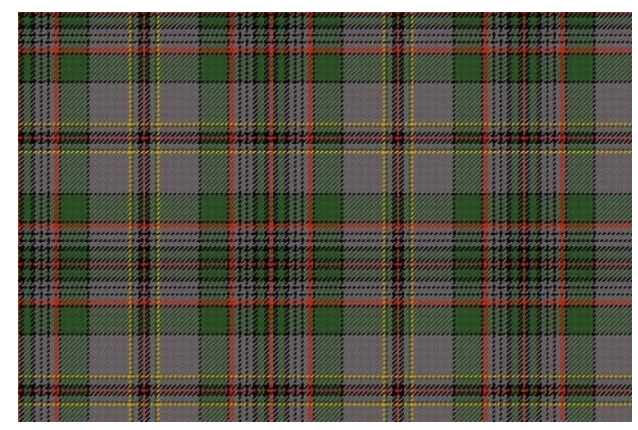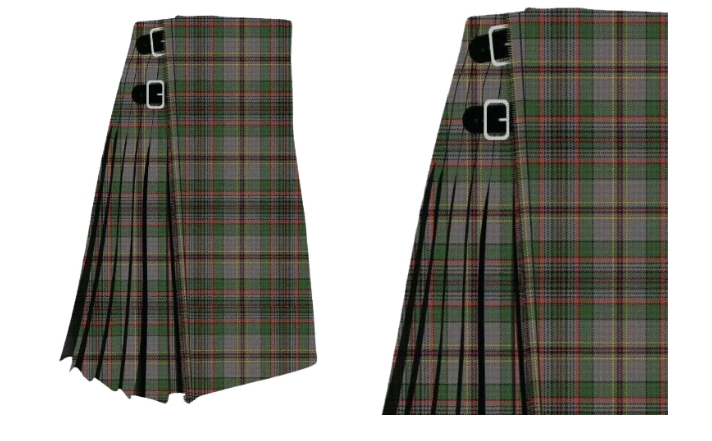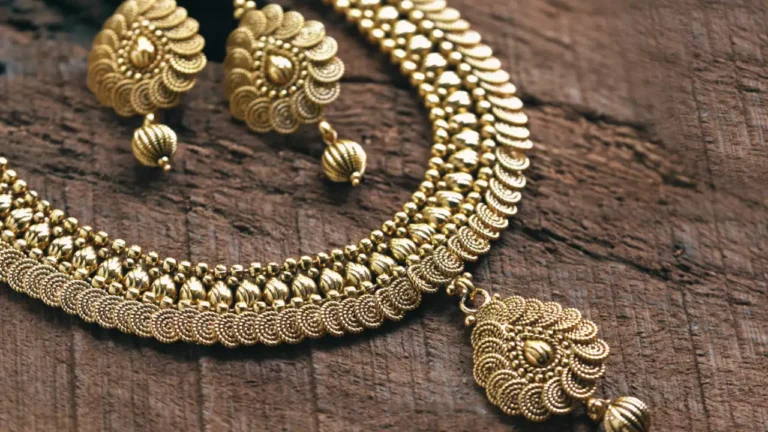What Are the Unique Features of the Craig Tartan in Scottish Culture?
The Craig Tartan, like many other clan tartans in Scotland, is more than just a fabric with a pattern. It carries the weight of history, identity, and tradition. For those associated with the Craig Clan, this tartan is a visual representation of their heritage, a way to connect with their ancestors, and a symbol of their Scottish roots. The tartan is intricately linked with Scottish culture and is a crucial part of various ceremonies and traditions. In this article, we’ll explore the unique features of the Craig Tartan, its historical significance, and how it continues to play an important role in modern times. The fascination with tartan extends far beyond Scotland’s borders. Across the world, people are drawn to these unique patterns, intrigued by their beauty and the stories they tell. The Craig Tartan, in particular, stands out for its distinct design and rich history. Whether you’re part of the Craig Clan, have Scottish ancestry, or are simply interested in Scottish culture, understanding the Craig Tartan offers a glimpse into a storied past and a vibrant tradition.

Historical Background of Craig Tartan
The history of the Craig Tartan is deeply intertwined with the history of Scotland itself. Tartan patterns were originally developed as a means of identifying different clans or families, each with its unique design that would distinguish them from others. The Craig Clan, with its own tartan, has been a part of this tradition for centuries. The origins of the Craig Clan can be traced back to ancient Scotland, where clans were essential social structures. These clans were more than just extended families; they were communities that provided support and protection to their members. The Craig Clan, like others, developed its unique tartan to signify its identity and heritage. This tartan was not just a piece of clothing but a statement of belonging and pride. As time passed, the role of tartan evolved, but its significance remained. During the Jacobite risings in the 18th century, tartans were used as a means of identification and solidarity among those fighting for the cause. The Craig Tartan, like others, became a symbol of resistance and unity. After the Jacobite defeat, the British government banned the wearing of tartans in an attempt to suppress Scottish culture and identity. However, this ban was eventually lifted, and tartans, including the Craig Tartan, saw a resurgence in popularity.
The Symbolism of Tartan in Scottish Culture
In Scottish culture, tartan is more than just a fabric pattern; it is a powerful symbol of identity, heritage, and community. Each tartan pattern is unique to a clan, family, or region, and wearing it is a way of expressing pride in one’s ancestry. The Craig Tartan is no exception, carrying deep symbolic meaning for those associated with the Craig Clan. Tartan symbolizes many aspects of Scottish life. It represents the rugged landscapes of the Highlands, the history of struggle and perseverance, and the tight-knit communities that have characterized Scottish society for centuries. For members of the Craig Clan, the Craig Tartan is a visual representation of their connection to these elements. It is a reminder of their roots, their family history, and their place within the broader tapestry of Scottish culture. The colors and patterns of the Craig Tartan are chosen not just for their aesthetic appeal but for their symbolic significance. Each color has a meaning, and the pattern tells a story. The tartan’s design is a form of visual storytelling, encapsulating the history and values of the Craig Clan. When worn at cultural events, the tartan serves as a badge of identity, allowing individuals to connect with their heritage and with each other.
Unique Features of the Craig Tartan
The Craig Tartan is distinguished by several unique features that set it apart from other tartans. These features include its distinctive pattern, the specific colors used, and the symbolic meanings attached to them. Understanding these elements provides a deeper appreciation of the Craig Tartan and its place in Scottish culture. The pattern of the Craig Tartan is a carefully crafted design that reflects the clan’s identity and heritage. Unlike some tartans that feature bold, contrasting designs, the Craig Tartan is known for its harmonious and balanced pattern. The lines and checks are arranged in a way that creates a sense of order and symmetry, reflecting the values and traditions of the Craig Clan. Color is a crucial aspect of any tartan, and the Craig Tartan is no exception. The colors used in the Craig Tartan are chosen for their symbolic significance and their visual appeal. The combination of green, blue, and black forms the foundation of the Craig Tartan, each color carrying its own meaning. Green often symbolizes the lush landscapes of Scotland, blue reflects loyalty and strength, while black denotes the resilience and fortitude of the Craig Clan.
Craig Tartan Patterns
The patterns of the Craig Tartan are a key element of its unique design. These patterns are created through a meticulous process of weaving, where the placement of each thread determines the final design. The resulting pattern is a harmonious blend of lines and checks that create a distinctive and recognizable look. The Craig Tartan features a balanced and symmetrical pattern, with lines of varying widths arranged in a specific order. This arrangement creates a sense of order and harmony, reflecting the values and traditions of the Craig Clan. The pattern is both simple and sophisticated, with a timeless appeal that transcends fashion trends. One of the defining characteristics of the Craig Tartan pattern is its use of repetition. The lines and checks are repeated at regular intervals, creating a sense of rhythm and continuity. This repetition is not just a design choice but also a symbolic one, representing the enduring nature of the Craig Clan and its traditions.
Colors Used in Craig Tartan
The colors used in the Craig Tartan are a crucial part of its design, each chosen for its symbolic significance and its visual appeal. The primary colors of the Craig Tartan are green, blue, and black, each with its own meaning and association. Green is often used in tartans to symbolize the lush landscapes of Scotland. For the Craig Clan, green represents the connection to the land and the natural beauty of their ancestral home. It is a color that evokes the rolling hills and verdant fields of the Scottish countryside, a reminder of the clan’s roots and heritage. Blue is another important color in the Craig Tartan. It is often associated with loyalty and strength, qualities that are highly valued by the Craig Clan. Blue also represents the skies and waters of Scotland, reflecting the clan’s connection to the natural elements and their enduring spirit. Black is a color that signifies resilience and fortitude. For the Craig Clan, black represents the strength and determination that have characterized their history. It is a color that speaks to the challenges and hardships the clan has faced, as well as their ability to overcome them. The choice of colors in the Craig Tartan is not just about aesthetics but also about symbolism. Each color tells a story, representing different aspects of the Craig Clan’s identity and heritage. By understanding the colors used in the Craig Tartan, one can gain a deeper appreciation of its cultural significance and its role in Scottish heritage.
Regional Variations
While the core design of the Craig Tartan remains consistent, there are subtle regional variations that add depth and richness to its overall character. These variations reflect the local influences and preferences, making the Craig Tartan a dynamic and adaptable design. Regional variations in the Craig Tartan can be seen in the shades of colors used or slight modifications in the pattern. For example, a Craig Tartan woven in one region might feature a slightly darker shade of green or a more prominent blue line. These differences are often subtle but significant, reflecting the unique characteristics of each region. The regional variations of the Craig Tartan are a testament to its adaptability and versatility. While the core design remains the same, these variations allow the tartan to be customized to reflect the specific preferences and traditions of different regions. This flexibility makes the Craig Tartan suitable for a wide range of uses, from traditional ceremonies to modern fashion. The regional variations of the Craig Tartan are not just about aesthetics but also about preserving local traditions and identities. Each variation tells a story, reflecting the unique history and culture of the region. By understanding these variations, one can gain a deeper appreciation of the Craig Tartan and its role in Scottish heritage.
The Role of Craig Clan in Scottish History
The Craig Clan has played a significant role in Scottish history, contributing to various historical events and cultural developments. From battles to political influence, the Craig Clan has left an indelible mark on Scotland’s history, and their tartan is a visual representation of their legacy. The origins of the Craig Clan can be traced back to ancient Scotland, where clans were essential social structures. These clans were more than just extended families; they were communities that provided support and protection to their members. The Craig Clan, like others, developed its unique tartan to signify its identity and heritage. Throughout history, the Craig Clan has been involved in various significant events. They have fought in battles, contributed to political movements, and played a role in shaping Scottish society. The Craig Tartan, with its distinctive design, has been a symbol of the clan’s presence and influence throughout these events. The Craig Clan’s role in Scottish history is not limited to warfare and politics. They have also made contributions to culture, art, and literature. Members of the Craig Clan have been involved in various creative and intellectual pursuits, enriching Scottish culture and heritage. The Craig Tartan, as a visual symbol, represents these diverse contributions and the clan’s enduring legacy.

Legacy of Scottish Kilts
Scottish kilts are an iconic symbol of Scottish heritage and culture, traditionally worn by men and boys in the Highlands. These garments, typically made from woolen fabric and featuring the tartan pattern of a particular clan, are wrapped around the waist and fastened with belts or buckles. Historically, Scottish kilts served both practical and ceremonial purposes, providing warmth and freedom of movement in the rugged Highland terrain. Today, Scottish kilts are worn at cultural events, festivals, and formal occasions such as weddings, where they symbolize pride in one’s ancestry and the rich traditions of Scotland. The kilt’s unique design and cultural significance make it a cherished garment that continues to be celebrated and worn by Scots and those of Scottish descent around the world.
Modern Adaptations of Craig Tartan
In contemporary times, the Craig Tartan has found its way into modern fashion and design, becoming a versatile and timeless choice. Designers often incorporate this classic pattern into clothing, accessories, and home décor, making it a popular and stylish option. One of the most common modern uses of the Craig Tartan is in fashion. The tartan is used to create a wide range of clothing items, from traditional kilts and skirts to modern jackets, trousers, and dresses. The timeless appeal of the tartan pattern makes it a popular choice for both casual and formal wear, allowing individuals to express their heritage while staying stylish. In addition to clothing, the Craig Tartan is also used in accessories. Items such as scarves, ties, handbags, and hats feature the distinctive pattern, adding a touch of Scottish heritage to everyday outfits. These accessories are popular not just in Scotland but around the world, reflecting the global appeal of the tartan. The Craig Tartan is also used in home décor, where it adds a touch of tradition and elegance to interiors. From blankets and cushions to curtains and upholstery, the tartan pattern is a versatile design element that complements a wide range of styles.
Craig Tartan in Festivals and Events
The Craig Tartan is a staple at Scottish festivals and events, where it is worn with pride and serves as a symbol of clan identity and heritage. Whether it’s the Highland Games, a traditional Scottish wedding, or a cultural festival, the Craig Tartan plays a central role in celebrating Scottish heritage. The Highland Games are one of the most significant events where the Craig Tartan is prominently displayed. These games, which take place across Scotland and in Scottish communities around the world, feature various traditional sports and cultural activities. Participants and spectators alike wear their clan tartans, with the Craig Tartan being a common sight among members of the Craig Clan. The tartan adds a sense of pride and unity to the event, connecting individuals to their heritage and to each other.
Conclusion
In conclusion, the Craig Tartan stands as a testament to the rich tapestry of Scottish culture and heritage. Its unique features, including intricate patterns, symbolic colors, and centuries-old traditions, make it a cherished emblem of the Craig Clan and a symbol of Scottish identity. From its origins in ancient Scotland to its modern adaptations in fashion and design, the Craig Tartan has remained a timeless symbol of pride and belonging for those connected to the Craig Clan. As we continue to celebrate Scottish culture and preserve its traditions, the Craig Tartan will undoubtedly continue to hold a special place in the hearts of Scots around the world, ensuring that its legacy endures for generations to come.
FAQs
1. How can I purchase authentic Craig Tartan products?
Authentic Craig Tartan products can be purchased from reputable Scottish retailers, online stores specializing in tartan merchandise, or directly from the Craig Clan’s official website.
2. Is there a specific occasion where wearing the Craig Tartan is appropriate?
The Craig Tartan can be worn on various occasions, including Scottish festivals, weddings, cultural events, and family gatherings. It’s a versatile tartan that adds a touch of tradition and heritage to any occasion.
3. Are there any rules or guidelines for wearing the Craig Tartan?
While there are no strict rules, it’s generally respectful to wear the tartan with pride and to treat it with care and reverence. It’s also advisable to learn about the history and significance of the tartan to fully appreciate its cultural importance.
4. Can anyone wear the Craig Tartan, or is it reserved for members of the Craig Clan?
While the Craig Tartan is traditionally associated with the Craig Clan, anyone with a connection to Scotland or an appreciation for Scottish culture can wear it. Many people choose to wear tartans as a way of honoring their Scottish heritage or simply because they admire the design.
5. How can I learn more about the history and significance of the Craig Tartan?
There are several resources available for learning about the Craig Tartan, including books, websites, and cultural organizations dedicated to Scottish heritage. Additionally, visiting Scotland and exploring its museums, historical sites, and tartan shops can provide valuable insights into the tartan’s history and significance.






